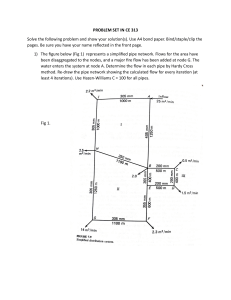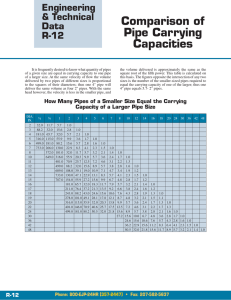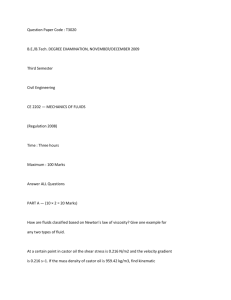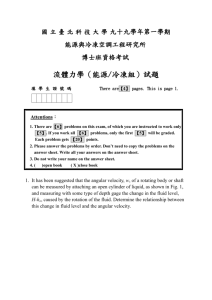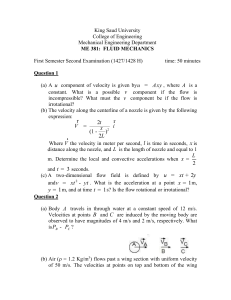overall mass balance & continuity equation
advertisement
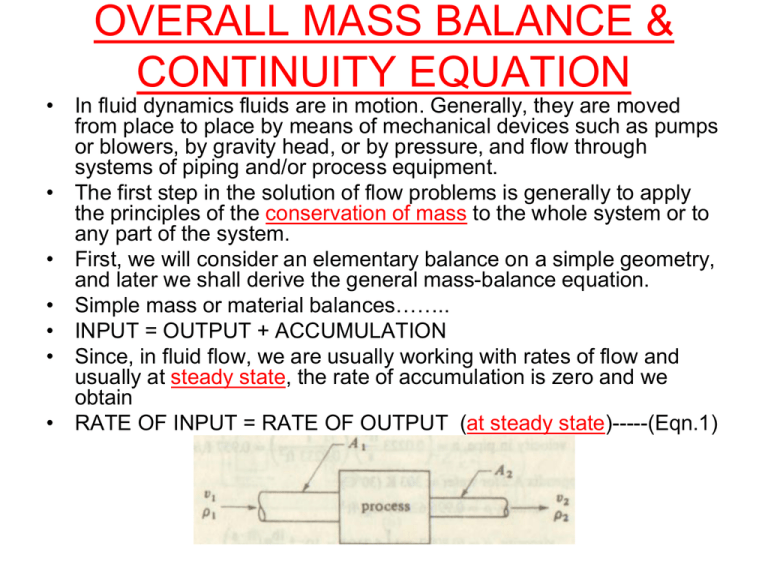
OVERALL MASS BALANCE & CONTINUITY EQUATION • In fluid dynamics fluids are in motion. Generally, they are moved from place to place by means of mechanical devices such as pumps or blowers, by gravity head, or by pressure, and flow through systems of piping and/or process equipment. • The first step in the solution of flow problems is generally to apply the principles of the conservation of mass to the whole system or to any part of the system. • First, we will consider an elementary balance on a simple geometry, and later we shall derive the general mass-balance equation. • Simple mass or material balances…….. • INPUT = OUTPUT + ACCUMULATION • Since, in fluid flow, we are usually working with rates of flow and usually at steady state, the rate of accumulation is zero and we obtain • RATE OF INPUT = RATE OF OUTPUT (at steady state)-----(Eqn.1) • In Fig.a simple flow system is shown where fluid enters section 1 with an average velocity v1 and density r1.The cross-sectional area is A1. • The fluid leaves section 2 with average velocity v2 • The mass balance, Eqn. (1), becomes m r1v1 A1 r 2 v 2 A2 if r1 r 2 r m r Continuity Equation Q v1 A1 v 2 A2 v1 A1 v2 A2 Prob 1 Flow of Crude Oil and Mass Balance A petroleum crude oil having a density of 892 kg/m3 is flowing through the piping arrangement shown in Fig. at a total rate of 1.388 x 10-3 m3/s entering pipe 1. 1.61” 2.067” The flow divides equally in each of pipes 3. The steel pipes are Schedule 40 pipe (see Appendix A.5 for actual dimensions). Calculate the following using SI units. (a) The total mass flow rate in pipe 1 and 3. (b) The average velocity v in 1 and 3. • a). Given, Vol flowrate Q1 = 1.388x10-3 m3/s • Mass flow rate = m1=r1 v1A1= 1.238 kg/s • Since flow divides equally in each of pipes 3, m3 = (m1 / 2) = 0.619 kg/s • b). v1 = Q1/A1 = 0.641 m/s • c). v3 = Q3/A3 = 0.528 m/s Prob 2 • Water flows steadily thro’ a 2” ID pipe @ a rate of 200gal/min. The 2” pipe branches into two 1” ID pipes. If the ave. velocity in one of 1” pipes is 30ft/s, what is the ave. velocity in other 1” pipe? v1 A1 v2 A2 v3 A3 • v2 = 15.722m/s Prob 3 • Water at 0.1m3/s and alcohol (s.g 0.8) at 0.3m3/s are mixed in a y duct as shown in fig. What is the ave. density of mix of alcohol and water?
